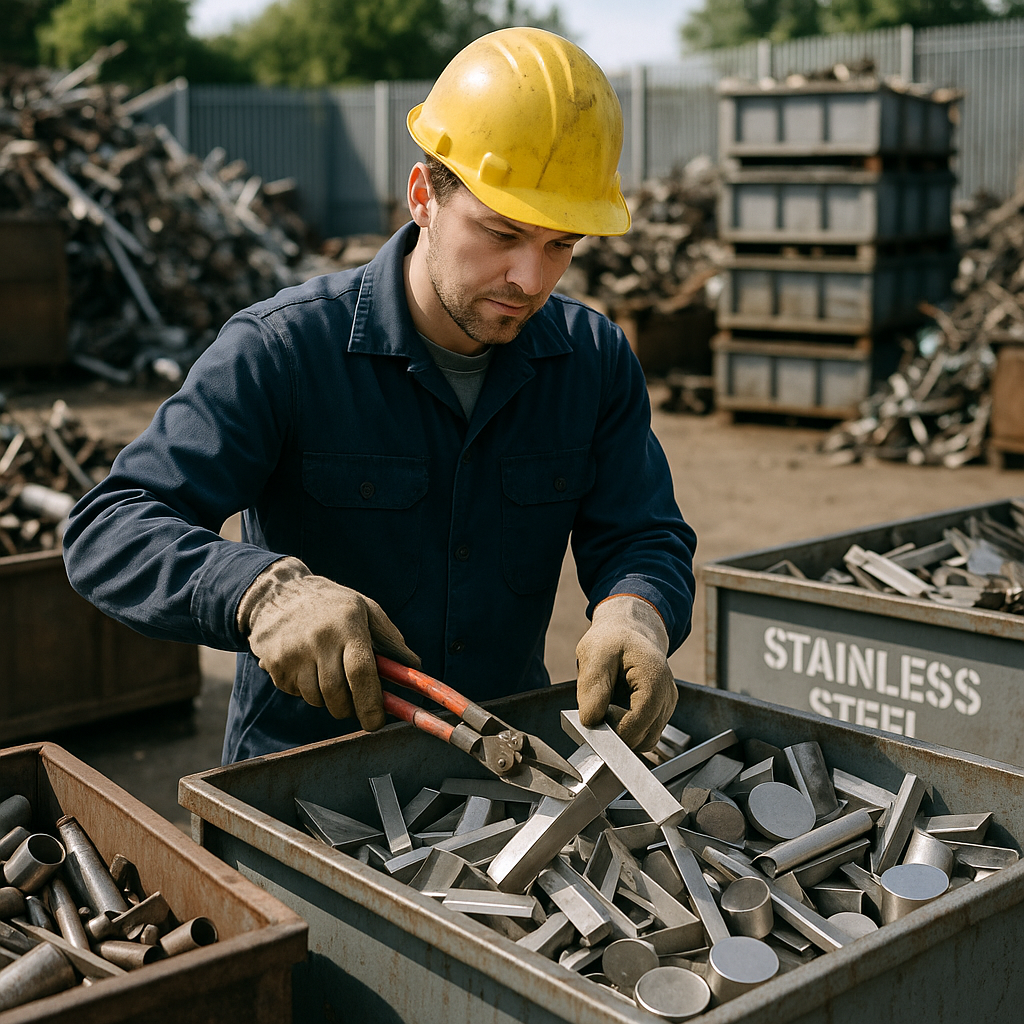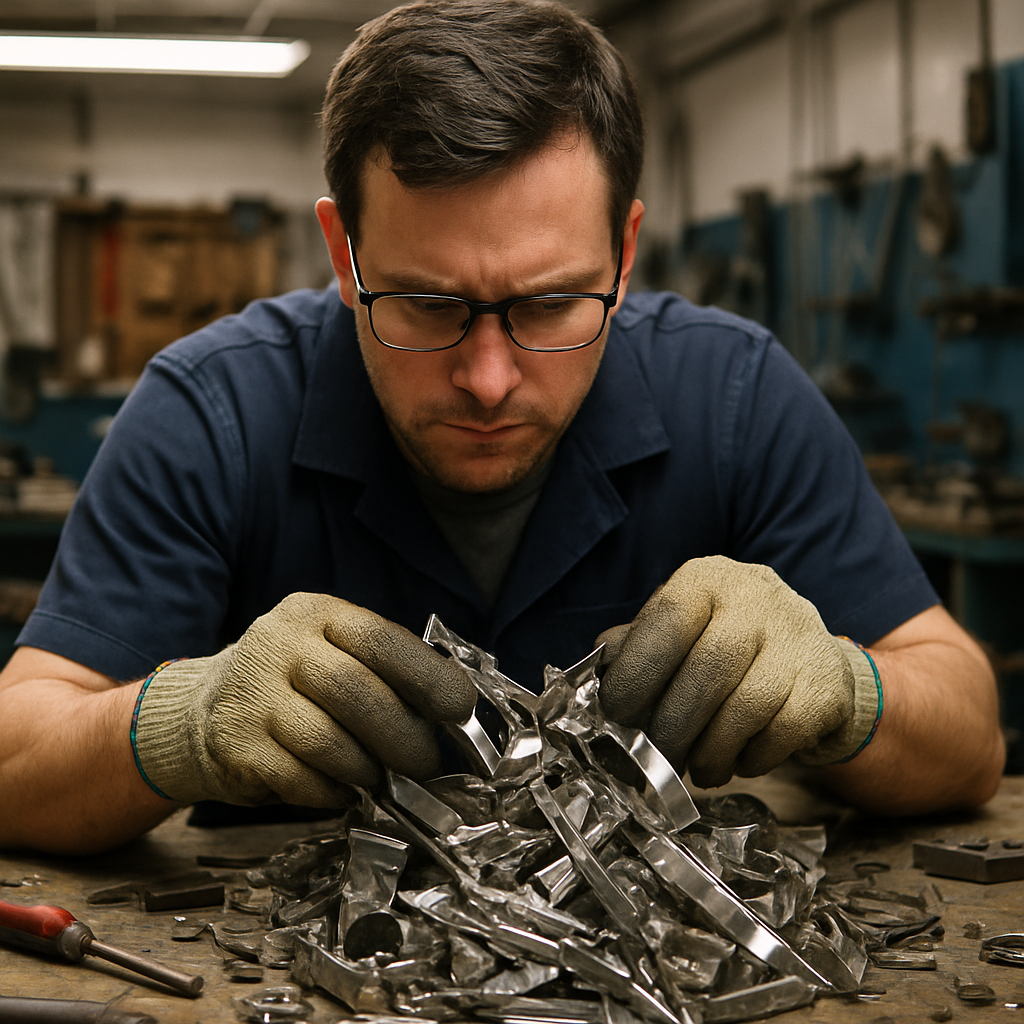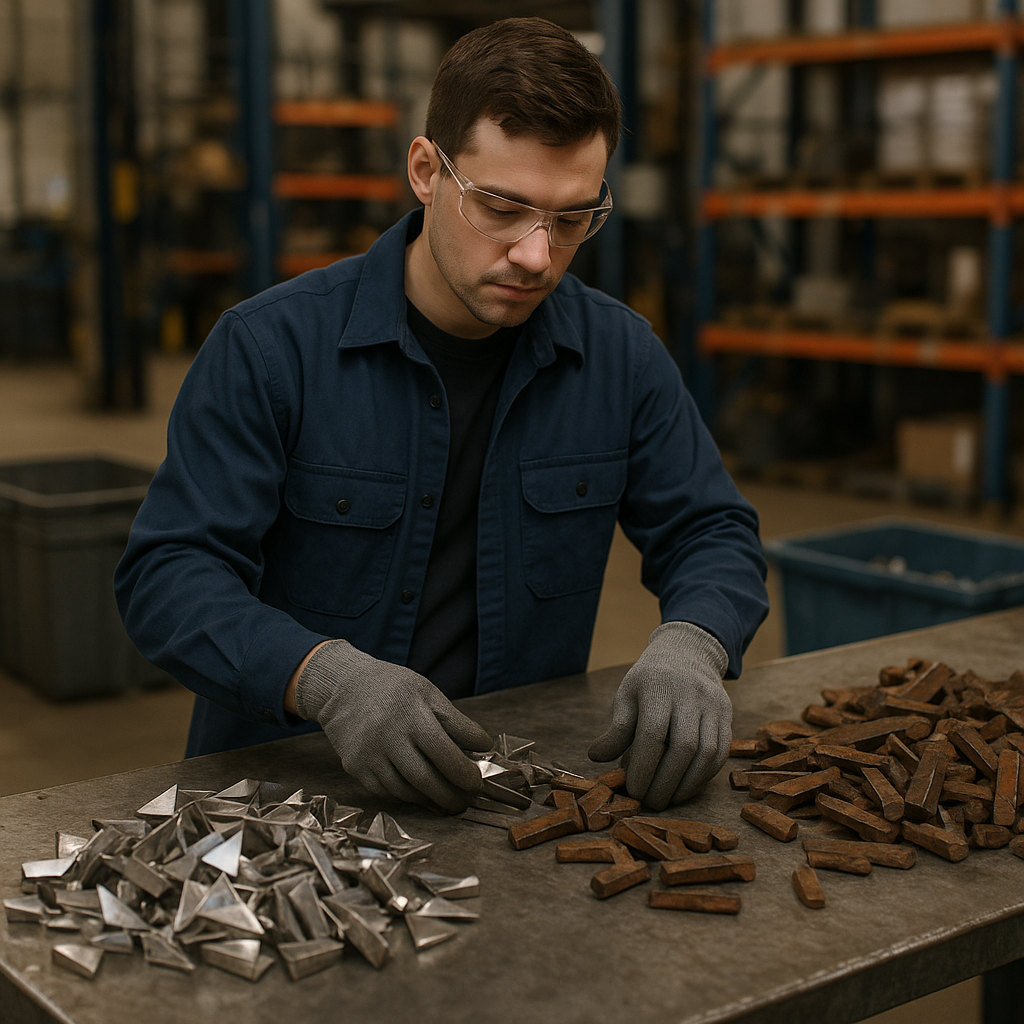5901 Botham Jean Blvd, Dallas, TX 75215
What is Scrap Stainless Steel and Why is it Valuable?
June 29, 2025In the recycling industry, few materials garner as much attention as stainless steel scrap. This versatile alloy offers significant opportunities for both businesses and individuals involved in metal recycling. Its unique properties and composition make it one of the more valuable materials in scrap yards worldwide.
Stainless steel is primarily an alloy composed of iron and at least 10.5% chromium, often supplemented with other valuable metals like nickel, copper, and molybdenum. Unlike regular steel, these additional elements give stainless steel its signature corrosion resistance and durability. This combination ensures the material retains its value even after its initial use.
Accurately identifying stainless steel scrap can significantly impact profitability in recycling operations. Stainless steel’s higher value compared to common ferrous metals means proper sorting can substantially increase returns. For recyclers, scrappers, and sustainability-focused businesses, understanding what makes stainless steel valuable provides a competitive edge in the circular economy of metal resources.
How Can Visual Inspection Help Identify Stainless Steel Scrap?

Visual inspection is one of the simplest methods for identifying stainless steel scrap in recycling operations. Stainless steel’s most obvious visual indicator is its shiny, sleek appearance, which maintains its luster even after extended use. Unlike regular steel, genuine stainless steel resists rust and corrosion under normal conditions.
When examining potential stainless steel scrap, look for a clean, mirror-like finish that reflects light uniformly. Kitchen sinks, high-end cookware, and commercial food preparation equipment typically have this distinctive appearance. Industrial applications often use stainless steel in chemical processing equipment, heat exchangers, and pharmaceutical manufacturing tools.
Surface finish offers another reliable visual cue. Stainless steel commonly exhibits brushed, matte, or polished finishes depending on its application. Appliances like refrigerators, dishwashers, and washing machines frequently use stainless steel with a brushed finish for its fingerprint-resistant properties and modern aesthetic.
The color and tone of stainless steel can help differentiate between grades. Austenitic stainless steel (300 series) typically displays a slightly warmer shine compared to the cooler tone of ferritic stainless steel (400 series). This subtle difference becomes apparent when comparing kitchen utensils (often 304 grade) with automotive trim components (frequently 430 grade).
Shape and form offer additional identification clues. Stainless steel appears in distinctive forms across industries. Medical equipment includes surgical instruments, sterilization trays, and laboratory fixtures. Commercial kitchens contain food preparation tables, exhaust hoods, and storage racks. Even the shape of screws and fasteners can indicate stainless steel, as they are commonly used in marine environments and outdoor applications where corrosion resistance is crucial.
Trained recycling personnel rely on visual examination of characteristics like color variations, surface texture, and component shapes to sort stainless steel grades efficiently. These sorting methods become more accurate with experience, allowing recyclers to maximize the value of collected materials.
What Physical Tests Can Be Used to Identify Stainless Steel Scrap?

Identifying stainless steel in your scrap pile is crucial for maximizing its recycling value. Several straightforward physical tests can help you distinguish stainless steel from other metals without expensive equipment. These tests rely on the unique properties of stainless steel alloys and can be performed on-site.
The Magnet Test
The magnet test is one of the simplest and most accessible methods for initial sorting. It works because different stainless steel grades have varying magnetic properties. When you place a magnet against the metal, you will observe one of these reactions:
Austenitic stainless steels (like the common 304 and 316 grades) are typically non-magnetic. If your magnet doesn’t stick, you likely have one of these valuable grades. Ferritic and martensitic stainless steels (such as 430 or 410) are magnetic and will attract the magnet strongly. Some duplex stainless steels show partial magnetic attraction.
While this test won’t identify the exact grade, it quickly separates your scrap into broad categories. Remember that cold-working or welding can sometimes make normally non-magnetic stainless steel slightly magnetic.
The Spark Test
For the spark test, you’ll need access to a bench grinder or angle grinder. When you lightly press the metal against the spinning grinder wheel, different metals produce distinctive spark patterns. Stainless steel creates characteristic sparks that can help identify it:
Austenitic stainless steels produce short, orange-colored sparks with few or no forks. The spark stream is typically subdued compared to carbon steel. Ferritic stainless steels create longer whitish sparks with small forks. Martensitic grades show spark patterns between these two extremes.
Perform this test in a dimly lit area for better visibility, and always wear proper eye protection. The distinct spark pattern of stainless steel differs noticeably from the bright, bursting sparks of carbon steel or the absence of sparks from aluminum.
The Brinell Hardness Test
The Brinell Hardness test measures the hardness of metal by pressing a hardened steel ball into the surface with a specific force. While professional Brinell testing requires specialized equipment, you can perform a simplified version to compare relative hardness between metals.
Use a sharp, hard object like a carbide scribe to attempt to scratch the surface. Stainless steel is typically harder than aluminum but softer than hardened tool steel. Austenitic stainless steels (304, 316) usually have Brinell hardness numbers between 160-190, while martensitic grades can reach 280 or higher after heat treatment.
This comparative hardness test won’t give you exact values but can help distinguish stainless steel from softer metals like aluminum or copper.
Weight Comparison Test
Stainless steel has a distinctive weight that helps identify it among other metals. This test is especially useful for distinguishing stainless steel from aluminum, which can look similar but weighs significantly less.
Stainless steel has a density of approximately 7.8-8.0 g/cm³, similar to carbon steel but much heavier than aluminum (2.7 g/cm³). If you have two pieces of similar size but one feels substantially heavier, the heavier piece is likely steel or stainless steel rather than aluminum.
For a simple comparison, hold similar-sized pieces in each hand. Stainless steel will feel noticeably heavier than aluminum but similar in weight to regular steel. This test works best when comparing pieces of similar dimensions.
Combining Tests for Accuracy
While each test provides valuable information, combining multiple tests yields the most reliable results. Start with the magnet test for initial sorting, then confirm with spark or weight tests. For non-magnetic samples, weight comparison helps distinguish between aluminum and austenitic stainless steel.
These simple physical tests allow for effective on-site identification of stainless steel scrap without expensive laboratory equipment. With practice, you can quickly sort your scrap metal and maximize its recycling value.
What Are the Different Grades of Stainless Steel Scrap?

Stainless steel scrap is categorized into distinct grades, each with unique compositions and recycling values. Understanding these differences is essential for proper sorting and maximizing returns in the recycling process.
300-Series: Austenitic Stainless Steel
The 300-series grades are non-magnetic austenitic stainless steels containing significant amounts of chromium and nickel. These grades offer excellent corrosion resistance and formability, making them prevalent in commercial and industrial applications.
304 stainless steel, often called 18/8 (18% chromium, 8% nickel), is the most common grade in the recycling stream. It typically commands prices around $0.32-$0.35 per pound in current markets. This grade is found in kitchen equipment, food processing machinery, and architectural applications.
316 stainless steel contains higher nickel content (10-14%) plus 2-3% molybdenum, which substantially increases its value. Current market prices for 316 grade scrap can reach $0.62-$1.05 per pound, significantly higher than other grades. The addition of molybdenum provides superior corrosion resistance, particularly against chlorides and acids, making this grade common in marine environments, chemical processing equipment, and medical devices.
400-Series: Ferritic and Martensitic Stainless Steel
The 400-series grades are magnetic and contain less nickel than the 300-series. These grades are divided into ferritic and martensitic types based on their carbon content and heat treatment.
410 stainless steel is a basic martensitic grade containing approximately 12% chromium with higher carbon content. This grade typically fetches only $0.05-$0.12 per pound in the scrap market. Its magnetic properties help in identification and separation from the more valuable 300-series grades. Common sources include automotive parts, knife blades, and turbine components.
430 stainless steel, a ferritic grade with 16-18% chromium but minimal nickel, usually trades at similar prices to the 410 grade. It is commonly found in automotive trim, appliances, and cookware.
Specialty Grades
Beyond the common 300 and 400 series, several specialty grades appear in the scrap stream:
309 and 310 stainless steels contain higher chromium (22-25%) and nickel (12-20%) for extreme heat resistance. These fetch premium prices, with the 310 grade commanding up to $0.98-$1.02 per pound. These grades typically come from heat-treating equipment, furnace parts, and high-temperature processing systems.
321 stainless steel contains titanium stabilizers that prevent carbide precipitation at high temperatures. This grade, common in aircraft exhaust systems and chemical processing equipment, brings approximately $0.47-$0.49 per pound in current markets.
Importance of Proper Identification
Correctly identifying stainless steel grades significantly impacts recycling value. The price difference between 316 and 410 grades can exceed $0.90 per pound. Recyclers use several methods to distinguish grades:
Magnetic testing separates the non-magnetic 300-series from the magnetic 400-series. Chemical spot testing can further differentiate between grades by identifying specific elements. Many recycling operations now employ handheld XRF (X-ray fluorescence) analyzers for precise grade identification.
Contamination between grades reduces the value of the entire lot, making proper sorting essential throughout the collection process.
How to Maximize Value When Recycling Stainless Steel Scrap

Recycling stainless steel scrap provides significant environmental benefits and financial returns. To optimize value, it is essential to sort and prepare the materials correctly. Accurately sorting different grades ensures the best possible price, as mixed loads are usually valued at the lowest grade present. Thoroughly cleaning to remove non-stainless components, plastics, rubber, and other contaminants prevents price reductions or even rejection by buyers. For operations handling larger volumes, investing in advanced identification methods like XRF analyzers can provide precise material composition data, aiding in the separation of high-value grades containing nickel and chromium from lower-value varieties.
Keeping informed about market trends is also crucial for maximizing returns. Regularly check current prices, as stainless steel scrap values fluctuate based on global economic conditions, raw material costs, and seasonal factors. Compare offers from multiple buyers, including local scrap yards, specialty metal recyclers, and online marketplaces to ensure fair value. For more consistent results, consider building relationships with reputable buyers who may offer more stable pricing and better terms over time.
For assistance with responsible stainless steel recycling and to get the maximum value for your materials, contact Okon Recycling at 214-717-4083.
